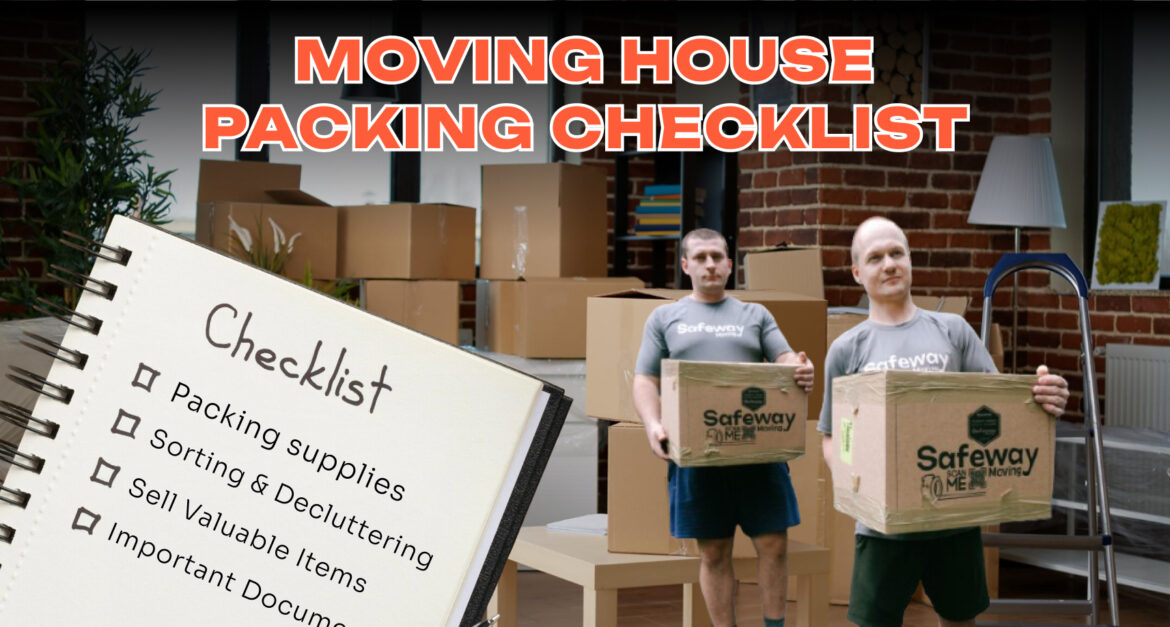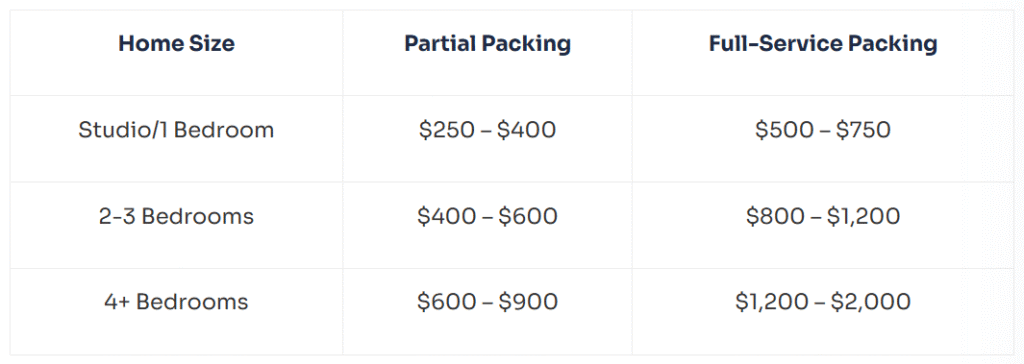
When it comes to moving house, packing can be the most overwhelming task. From deciding what to keep and what to discard, to making sure every box is labeled and secure, there’s a lot to consider. A comprehensive moving house packing checklist not only helps streamline the process but also prevents last-minute chaos. In this blog, we’ll explore everything you need to know for a stress-free packing experience, ensuring your transition to a new home is as smooth as possible. If you’re looking for professional help, Safeway Moving offers reliable and efficient packing services tailored to your needs.
Why You Need a Moving House Packing Checklist
Creating a detailed packing checklist isn’t just about staying organized. It’s about saving time, reducing stress, and ensuring nothing important is forgotten during the transition. Whether you’re moving across town or across the country, planning is key.
Firstly, a packing checklist breaks the process into manageable steps, making the task feel less daunting. You’re able to tackle each room one by one and avoid feeling overwhelmed by the magnitude of the move. Moreover, it helps identify what supplies are needed in advance, boxes, tape, markers, bubble wrap, so you can avoid unnecessary trips to the store.
Secondly, the checklist serves as a record for all packed items. When you arrive at your new home, you won’t be left wondering which box contains your coffee maker or your child’s school supplies. This level of organization makes the unpacking process faster and more efficient.
Benefits of a checklist:
- Efficiency and clarity: Knowing exactly what to do and when to do it helps you avoid backtracking.
- Minimized loss: Each item is accounted for, reducing the risk of forgotten belongings.
- Streamlined coordination: If you’re hiring movers or getting help from friends, a checklist can guide everyone on what needs to be done.
Essential Supplies You’ll Need for Packing
Before you start packing, it’s crucial to gather all the necessary materials. Skipping this step can lead to inefficiency, fragile items being damaged, and general confusion on moving day. While basic supplies like boxes and tape may seem obvious, there are many other items that make a big difference.
Invest in quality moving boxes of different sizes. Small boxes are ideal for heavy items like books, while large boxes are best for lighter, bulkier items such as bedding. Don’t underestimate the importance of packing paper and bubble wrap, these materials protect your breakables and keep them intact during the move. And of course, strong packing tape and permanent markers are essential.
Here’s a comprehensive list of supplies to have on hand:
- Sturdy cardboard boxes: Small, medium, and large. Consider double-walled for fragile items.
- Packing tape and tape gun: High-quality tape ensures boxes remain sealed.
- Bubble wrap and packing paper: Ideal for wrapping dishes, glasses, and electronics.
- Stretch wrap and furniture pads: Prevents scratches and keeps furniture safe.
- Labeling materials: Permanent markers and color-coded stickers for each room.
- Ziploc bags: Useful for small parts like screws and cords.
- Scissors and box cutters: Sharp tools make opening and sealing boxes easier.
Safeway Moving can also provide all the essential packing supplies as part of their professional packing service, saving you the time and hassle of sourcing materials on your own.
Room-by-Room Packing Guide
Rather than packing at random, it’s best to approach the task room by room. This method ensures that items are grouped logically and can be unpacked more easily at your destination.
Start with rooms that are used less frequently, such as guest bedrooms or storage areas. Leave everyday essentials like kitchenware, toiletries, and clothes for the final stages of packing. Make sure to clearly label each box with the room name and a summary of its contents.
Packing strategy by room:
- Living Room: Wrap electronics and secure cords. Use specialty boxes for TVs and artwork.
- Kitchen: Pack dishes with lots of padding. Use small boxes to avoid heavy loads.
- Bedrooms: Use wardrobe boxes for clothes. Vacuum-seal seasonal garments.
- Bathrooms: Dispose of expired items. Pack toiletries in plastic bags to prevent leaks.
- Garage/Basement: Label tools and dispose of hazardous materials properly.
Safeway Moving’s team has years of experience packing each room efficiently. With their room-by-room approach, your belongings stay safe and organized throughout the move.
Special Care for Fragile and High-Value Items
Fragile and high-value items require extra attention during the packing process. It’s not enough to wrap them once and hope for the best, these belongings need layers of protection and proper placement within moving boxes.
Begin by wrapping each item in packing paper and then bubble wrap. Place the item in a box with plenty of cushioning material, such as foam peanuts or crumpled paper. Avoid leaving any empty spaces that allow items to shift. Clearly mark these boxes as “FRAGILE” on all sides and make sure they are loaded last and unloaded first.
Tips for protecting fragile items:
- Plates and glassware: Use dish boxes with dividers. Wrap each piece separately.
- Electronics: If possible, use original boxes. Remove batteries and cables.
- Artwork and mirrors: Wrap in stretch wrap and place in mirror cartons.
- Jewelry and documents: Keep these with you, rather than in the moving truck.
To make this process hassle-free, Safeway Moving offers custom packing solutions specifically designed for fragile items. Their team uses premium materials and proven methods to ensure maximum protection.
What to Pack Last and First
Timing is everything when it comes to packing. While it may be tempting to pack everything as soon as possible, it’s smarter to prioritize and pack in stages. This way, you’re not left scrambling for everyday necessities in the final days leading up to your move.
Start by packing non-essentials and seasonal items you won’t need right away. Gradually move toward daily-use items, and leave your essentials for a final “Open First” box. This box should include items you’ll need immediately upon arrival, think toiletries, basic kitchen supplies, chargers, and a change of clothes.
Pack last:
- Toiletries and medications
- Cell phone chargers and electronics
- Everyday kitchen items
- Children’s essentials and pet supplies
- Important documents and valuables
Pack first:
- Decor and wall hangings
- Books and media
- Out-of-season clothing
- Spare linens and towels
Safeway Moving helps coordinate the packing process in logical phases, so you don’t feel rushed or confused on moving day. Their experts guide you on what to pack and when, making the experience smooth and efficient.
Estimated Cost of Packing Services
Hiring professional packers can save you time and protect your belongings from damage. But what does it cost? Packing service pricing depends on the size of your home, the volume of items, and whether you need full-service or partial packing.

Safeway Moving offers customizable packing plans to suit your needs and budget. Whether you want help packing a few rooms or the entire house, their team provides high-quality service with transparent pricing.
It’s best to start packing 4–6 weeks before your move. Begin with items you rarely use, such as seasonal decorations or books. Gradually work your way toward everyday items so you’re not overwhelmed at the last minute.
Avoid packing important documents, valuables, medications, and perishable food. Keep these items with you in a separate box or bag during the move to ensure their safety and accessibility.
Yes, Safeway Moving offers full-service moving, which includes professional packing and unpacking services. Their team ensures your items are securely packed and efficiently unpacked in your new home.
Label every box with the room it belongs to and a summary of contents. Keep an “Open First” box with essentials. Safeway Moving also provides unpacking services to help you settle in quickly and stress-free.










